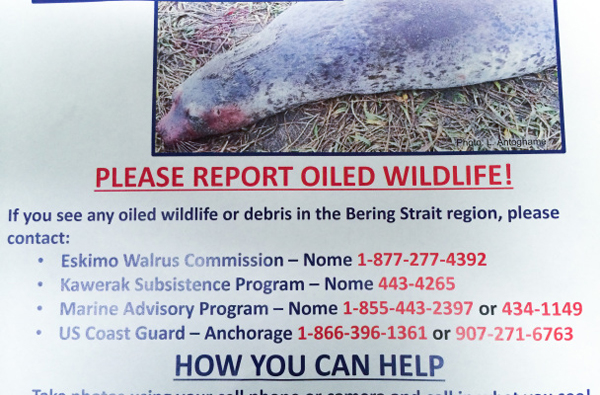
Two seals recently harvested off Gambell were found coated with a dark oily substance. While the hunters on St. Lawrence Island believe it was oil on the animals’ coats, testing done by the Alaska Department of Environmental Conservation has not confirmed that.
“They tested the flipper samples that were sent in from each seal—a front flipper. And there was no petroleum product on the flippers that were tested,” said Gay Sheffield, Marine Advisory Program agent at UAF. “There are some other skim samples that were sent in from the jaw and face area, and I have not heard the results of those.”
Sheffield is a member of the local team searching for the source of the oily substance—and she said it’s reminding her of the oiled seals harvested in 2012. Laboratory tests found that two seals that were taken from near St. Lawrence Island two years ago were, in fact, oiled. That’s why Sheffield was nervous when two more stained seals were found this year.
This is not a common occurrence for our region, and Kawerak Subsistence Director Brandon Ahmasuk says it’s challenging to pinpoint the source due to the small number of oiled animals found in the wide area. Still, he said, he’s frustrated by the lack of answers and the shortage of help from larger agencies like the U.S. Coast Guard.
“It’s a food security for the inhabitants of the region. You know, this is their food—they don’t take it lightly,” said Ahmasuk. “But outside agencies don’t seem to take that into consideration that this is a people’s food source. They can’t simply go to Walmart Supercenter or Fred Meyer’s. Their supercenter…it’s the sea. It’s just that plain and simple. But more often than not it’s just overlooked.”
In order to not get overlooked, Ahmasuk said, he and Sheffield, through local organizations, have emphasized their concerns to state and federal agencies.
“Because they are so far away from us, a lot of stuff we have to do ourselves,” said Ahmasuk. “When one of the residents from the surrounding villages come across something… I mean, for the past three years, now? Me and Gay, we’ve been sending out the word for sick seals, oiled wildlife, anything out of the ordinary to give us a call.”
While local responders are closer in case of a crisis, the Coast Guard has much-needed resources—however, those resources are based out of Kodiak, and Ahmasuk said they’re not guaranteed to be close by in case of an emergency.
The Coast Guard is the lead response agency for oil pollution and is required to test potential oil samples, like the ones Sheffield submitted from the two seals, in order to determine the source—sort of like an oil fingerprint. That’s while DEC runs tests to see if the substance is actually oil. Sheffield also sent tissue samples to the North Slope Borough Department of Wildlife Management, which she said assisted with testing back in 2012.
Meanwhile, a local pilot reported seeing an oil-like substance in the water between Shishmareff and Wales about two weeks ago. Sheffield filed a report with the National Response Center and says the Coast Guard was scheduled to do a C-130 reconnaissance flight over St. Lawrence Island and the Bering Strait area late last week. The two incidents are thus far unconnected, but Sheffield and Ahmasuk say they’re waiting for more information, and they’re asking anyone who sees oiled wildlife to take a picture, and contact them immediately.




